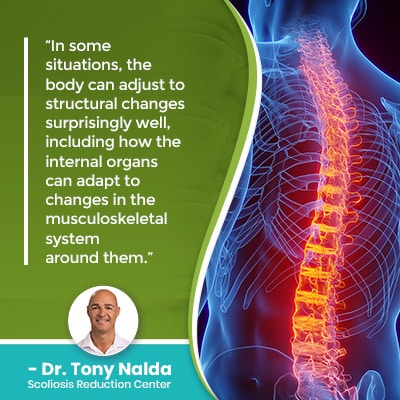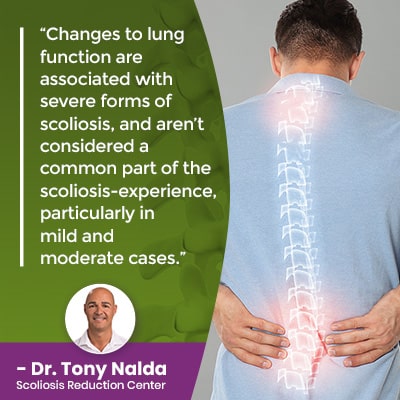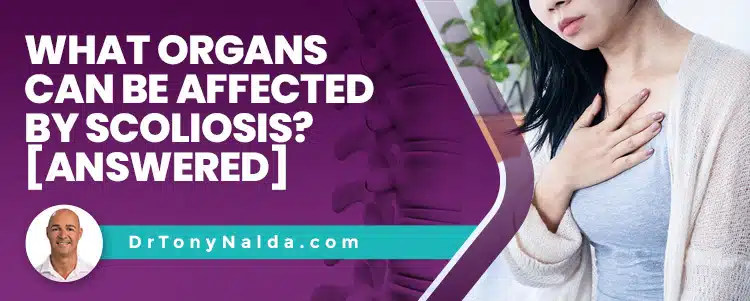Although organs can be affected by scoliosis, it’s not a common complication, and is more related to severe and very-severe cases, particularly those that are left untreated. When organs are affected, this can involve the lungs as they can be left with less room to function within, due to the development of a rib arch: a postural symptom of scoliosis.
Each case of scoliosis is unique, and each patient will respond to their scoliosis, and treatment, in their own way. While scoliosis is a spinal condition, it can affect multiple areas/parts of the body, including the lungs. When severe, and/or if left untreated, scoliosis can cause lung impairment.
Before getting to the specific ways in which scoliosis affects the body, let’s first start with explaining what a diagnosis of scoliosis really means.
What it Means to be Diagnosed with Scoliosis
Being diagnosed with scoliosis means an unnatural sideways spinal curve, that also rotates, has developed, and this means the body is going to be exposed to a lot of uneven forces.
Scoliosis is also a progressive condition, meaning its nature is to get worse over time, and as scoliosis gets more severe, its symptoms and affects tend to become more noticeable.
So where a scoliosis is at the time of diagnosis is not indicative of where it will stay; only proactive treatment can work towards counteracting the condition’s progressive nature.
Scoliosis is going to be the simplest to treat early in its progressive line, when the spine is going to be its most flexible and responsive to treatment, and before the body has had time to adjust to the unnatural spinal curve’s presence.
Scoliosis ranges widely in severity, and its severity levels are also its progressive line: mild to moderate and severe to very severe.
Scoliosis severity is determined by a measurement known as Cobb angle, and this measurement involves drawing lines from the tops and bottoms of the curve’s most-tilted vertebrae, and the resulting angle is expressed in degrees.
The higher a patient’s Cobb angle, the more severe the condition, and the more noticeable its effects are likely to be:
- Mild scoliosis: Cobb angle measurement of between 10 and 25 degrees
- Moderate scoliosis: Cobb angle measurement of between 25 and 40 degrees
- Severe scoliosis: Cobb angle measurement of 40+ degrees
- Very-severe scoliosis: Cobb angle measurement of 80+ degrees
So now that we’ve defined the condition and discussed its progressive nature, let’s move on to addressing how scoliosis affects the body, including what organs can be affected by scoliosis.
Scoliosis Symptoms
As mentioned, no two cases of scoliosis are the same, but there are some common symptoms.
In addition to ranging widely in severity, there are also different types of scoliosis, and scoliosis affects all ages.
As scoliosis doesn’t become a compressive condition until adulthood, this is when it tends to start causing noticeable back pain, which is the number-one symptom that brings adults in to see me for a diagnosis and treatment.
In children, as their spines are still growing, the constant lengthening motion of a growing spine counteracts the compressive force of the unnatural spinal curve, and it’s compression of the spine and its surrounding muscles and nerves that causes the majority of condition-related pain.
So while children can experience scoliosis-related back and muscle pain, back pain isn’t generally considered a common symptom of scoliosis in children.
Muscle pain is particularly common as scoliosis can cause a muscle imbalance related to the unnaturally-curved spine pulling its surrounding muscles in different directions; the muscles on one side of the spine can become stretched from overuse, while the muscles on the opposite side can become weak from underuse.
In children, the most noticeable symptom of scoliosis is postural deviation, and in the condition’s most-prevalent type, adolescent idiopathic scoliosis (AIS), it’s often uneven shoulders and hips that are the condition’s earliest effects.
The idiopathic designation means not clearly associated with a single known cause, and while we don’t understand why idiopathic scoliosis develops, we do know what triggers its progression: growth and development.
So adolescents are at risk for rapid-phase progression because of the stage of puberty, characterized by rapid and unpredictable growth spurts, they are in, or are entering into.
Postural changes are related to the condition’s uneven forces disrupting the body’s overall symmetry and can also include:
- Head uncentered over the torso
- Uneven eye line
- Uneven shoulder blades with one protruding more on one side than the other
- Development of a rib arch
- Uneven waistline
- Arms and legs that appear to hang at different lengths
As a result of these types of postural changes, clothing can suddenly seem ill-fitting, and changes to balance, coordination, and gait are also common.
So considering the types of postural changes the condition can cause, how do those changes affect the organs, and in particular, the lungs?
What Organs are Affected by Scoliosis?

In some situations, the body can adjust to structural changes surprisingly well, including how the internal organs can adapt to changes in the musculoskeletal system around them.
Scoliosis doesn’t just affect the spine, but also its surrounding nerves and muscles, and as the condition disrupts the body’s symmetry, causing postural changes, in some cases, organs can be affected by changes to their surroundings.
For example, the organs most commonly affected by scoliosis are the lungs, which are among the largest organs in the body, but even in those cases, they are severe, very severe, and/or have been left untreated.
And even in severe cases, lung impairment related to scoliosis is likely to go unnoticed, except by patients who place higher-than-average demands on their respiratory systems, like professional athletes.
Scoliosis can develop in any of the spine’s main sections: cervical spine (neck), thoracic spine (middle/upper back), and the lumbar spine (lower back).
In scoliosis, and the majority of spinal conditions, most of the spinal condition’s direct effects will be felt by the area of the body located closest to the affected spinal section.
In cases of thoracolumbar scoliosis, as the thoracic spine is the largest spinal section and is attached to the rib cage that protects internal organs within, the development of a rib arch can be a common postural change.
As the unnaturally-curved spine is pulling on the rib cage, its position can be disrupted by the condition’s uneven forces, and a rib arch can develop, and this can cause a loss of space for the lungs to function within, making it more difficult to inhale/exhale deeply.
However, if you recall, scoliosis ranges widely in severity, and in most cases, lung impairment isn’t an issue, or even if there are changes to lung function related to scoliosis, they are likely to go unnoticed by the average person.

Changes to lung function are associated with severe forms of scoliosis, and aren’t considered a common part of the scoliosis-experience, particularly in mild and moderate cases.
Conclusion
Scoliosis is a complex 3-dimensional progressive spinal condition, and as such, it can affect the body in a multitude of ways; as its nature is to get worse over time, the chosen treatment approach can have far-reaching effects.
The most common symptom of adult scoliosis is back pain and pain that radiates into the extremities due to nerve compression; in children, the condition’s most common effects are postural changes that reflect a disruption to the body’s overall symmetry.
While the organs aren’t overly affected by scoliosis, in severe cases, and/or when treated, these types of complications are more likely.
For example, when severe, and particularly in cases of scoliosis that involve the thoracic spine, the development of a rib arch is common, and this can result in less room inside the chest cavity for the lungs to function optimally within.
When lung impairment is an issue, it’s most likely to be noticed and affect those who place a lot of demand on their respiratory systems, such as long-distance runners.
The lungs are the organs most commonly affected by scoliosis, but this is associated with severe and very-severe cases, and/or in adult patients whose conditions have been previously untreated.
The more severe a condition, the larger the unnatural spinal curve is, the more uneven forces are being exposed to the body, the more noticeable its effects are likely to be, and the more complex it is to treat.
While there are no treatment guarantees, early detection and intervention are associated with increased treatment efficacy, and here at the Scoliosis Reduction Center®, I value proactive treatment that’s started as close to the time of diagnosis as possible, when conditions are at their mildest and going to be the most responsive to treatment.




